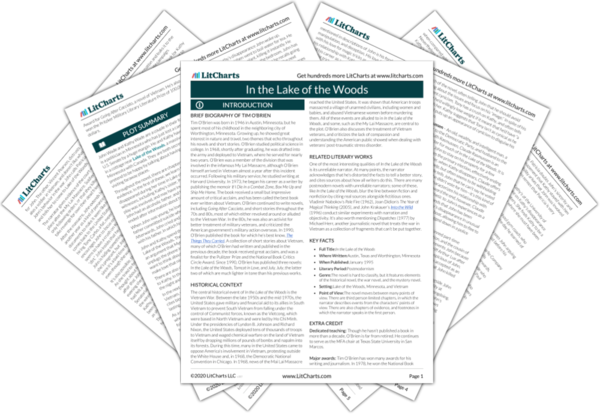Summary
Analysis
We come to another list of evidence. The first piece of evidence is a transcript of Rusty Calley’s court-martial, in which he says that he used a hand grenade to “evacuate” people. More pieces of evidence establish that Thuan Yen is the correct name for My Lai, the site of the infamous Vietnam War massacre. Paul Meadlo, a soldier at My Lai, testifies that he shot children and babies. His mother, Mrs. Myrtle Meadlo, says that the military turned him into a murderer.
Much of the evidence in this chapter is about Vietnam and the actions of soldiers there. The name “My Lai” triggers all sorts of associations for the reader—it was at My Lai, after all, where one of the most infamous massacres perpetrated by US Soldiers during the Vietnam War took place. The implication of Mrs. Meadlo’s quote is that the soldiers themselves aren’t guilty of wrongdoing to the extent that the military itself is guilty.
Themes
Tony Carbo says that John handled “it” in his own way, but adds that John was destroyed long before “it” destroyed him. Other soldiers in Vietnam claim not to remember “it”—Calley, for instance, can’t recall how many dead bodies he saw in a ditch, though Paul Meadlo claims that Calley pushed people into the ditch and then shot them. Eleanor claims not to believe anything people said about John during his campaign.
The absence of any explanation of what “it” is makes “it” seem much more disturbing—we can fill in the blanks and imagine anything we want. Some people, such as Eleanor, react to the news about Vietnam with denial—she refuses to believe that her own son could have done anything wrong.
Themes
In a court-martial, soldiers from Vietnam are asked to testify about the size of a ditch. Most refuse to say anything about it, but a few admit to remembering women and children, and seeing other soldiers shoot them. We’re also presented with a box of John’s “tricks,” dating from the time after he returned from the war: 12 photographs of his father, a deck of cards, an empty bottle of vodka, magic books, and medals, including a Purple Heart and a Bronze Star.
It’s telling that the soldiers can’t even answer questions about the ditch—the scope of the events at My Lai is so enormous that soldiers struggle to talk about it—in part, no doubt, because they’re grappling with intense guilt about their role there. John’s collection of “tricks” suggests that it was his experience at My Lai that drove him to alcoholism, but also that he gained a reputation for heroism there.
Themes
J. Glenn Gray, author of a book on war and trauma, is quoted as saying that a soldier is often given orders that clash with his definition of right and wrong. Richard Thinbill complains once again about flies. A soldier named Salvatore LaMartina claims that everyone at My Lai was following the orders they’d been given.
Get the entire Lake of the Woods LitChart as a printable PDF.

Dennis Conti, another soldier at My Lai, testifies in a court-martial that Calley ordered other men to shoot dozens of women and children, even after the soldiers had tried to avoid killing them. When Calley gave the order, the soldiers fired, and pieces of flesh flew into the air. One soldier, Robert Maples, refused to shoot the soldiers, even after Calley ordered him to do so.
We see the various ways that soldiers dealt with My Lai and the other atrocities of war. Some refused to be involved; others, like Calley, seemed to enjoy the killings. Most, however, went along with their orders, even though these orders conflicted with their sense of right and wrong.
Themes
Dennis Conti admits that he dragged Vietnamese women on the ground and talked about raping them. The author Fyodor Dostoevsky is quoted as saying that all men have secrets they only tell their friends, and still others that they never tell anyone. Patricia says that John used to yell in his sleep, and Vinny claims that “something was wrong” with John. Colonel William V. Wilson, a U.S. Army Investigator, says that the crimes of American soldiers at Son My Village include murder, rape, sodomy, and assault.
We return to the question of secrets. We already knew John had secrets, and always had, but now we see the scope of his secrecy. John could have been involved in any number of things at My Lai—we already know that he killed one of his fellow soldiers. Our lack of knowledge about John’s behavior makes us assume the worst—no news is bad news.
Themes












